Genizah Fragments of Saadiah’s tafsīr by Samuel ben Jacob: T-S AS 72.79 and T-S Ar.1a.38 Revisited
1. Introduction
In this space exactly thirteen years ago, Ronny Vollandt discussed several fragments from the Taylor-Schechter Collection that he astutely attributed to the 11th-century scribe Samuel ben Jacob.1 There were three fragments in all: one from CUL T-S AS 72.79, and two from CUL T-S Ar.1a.38. All three are from Exodus, all three are less than 50 percent extant, and all three are blank on the reverse (codices typically have writing on both sides of a leaf).





CUL T-S AS 72.79 (f. 1) CUL T-S Ar.1a.38 (f. 1) CUL T-S Ar.1a.38 (f. 2)
Exodus 25.3b–5a Exodus 32.6b–7a Exodus 32.2b-32.3a
What makes the above three scraps interesting is their similarity with a manuscript from St Petersburg that was acquired from somewhere in the Middle East (almost certainly Egypt) by the well-known 19th-century Karaite collector, Abraham Firkovich. This manuscript, St Petersburg EVR II C 1, contains the five books of Moses using the singular format found in the above three Genizah leaves: a Hebrew verse followed by its translation into Arabic (the tafsīr). Both the Genizah leaves and II C 1 are written on paper, and are of approximately the same width (the heights of the leaves cannot be compared): 21.2 cm for the Genizah fragments; 210 mm for II C 1, a difference of 2 mm.2
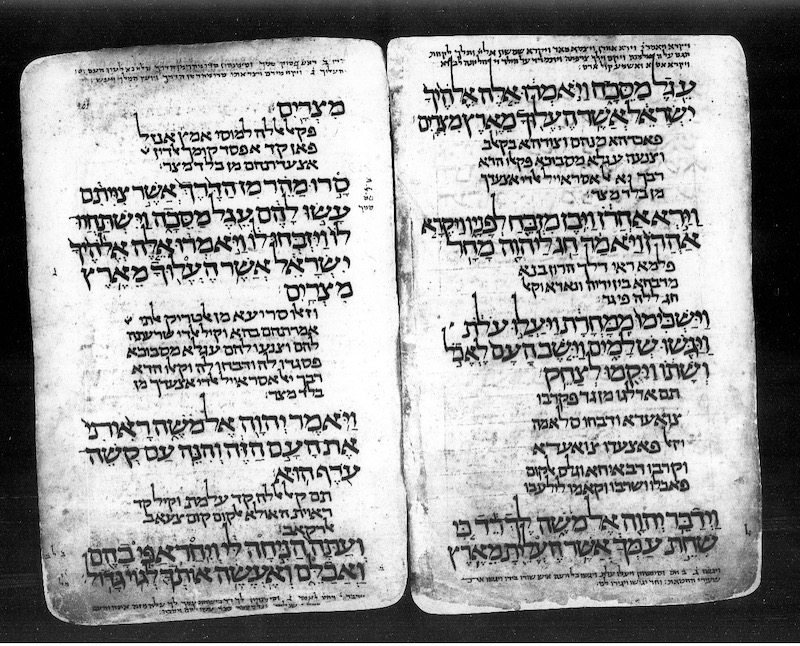
St Petersburg EVR II C 1 (microfilm 1d, f. 201 verso, f. 202 recto), Exodus 32:4–10
Faced with the obvious similarity between the Genizah classmarks and II C 1, plus the fact that the text of II C 1 overlaps with the Genizah fragments—and thus cannot be part of II C 1 as it currently stands, Vollandt concluded that these fragments appear to attest to yet another codex from the pen of Samuel ben Jacob.
While I concur with the Samuel ben Jacob attribution,3 the assumption that these three fragments represent a heretofore unknown codex should perhaps be reconsidered. An alternative—and, to my mind, more compelling—explanation is that the three Genizah leaves were originally part of II C 1, but then replaced with the current leaves at some point during the composition process. If my solution is correct, this would help to explain why a codex that once comprised an ostensible several hundred pages has only three extant leaves to its name (II C 1 in its now tattered condition still contains over 500 leaves).
2. CUL T-S AS 72.79 and Its Replacement Leaf in II C 1
The leaves of II C 1 are ruled for 19 lines of main text, with additional lines both supra and infra to guide the placement of Masorah magna. When writing in Hebrew, the letters are written at a size of one row of words per line; when writing in Judeo-Arabic for the tafsīr, the letters are written generally at a size of 1.5 rows of words per line. This layout results in anywhere from ca. 130–210 large Hebrew letters per page, depending upon the length of the verses, how they fit upon the page, etc.
A notable exception to the above described text density is the leaf of II C 1 (1d, f. 172) that overlaps text with T-S AS 72.79. Consider that:
- the recto and the verso use only 17 lines for the main text, instead of the standard 19;
- the Masorah magna is expanded supra to make the reduced line number less obvious;
- in several instances, Hebrew text that would have fit on one line (cf. the layout of the Genizah fragment) was dropped to the following line in an apparent attempt to expand the number of lines needed;
- the Judeo-Arabic is written at a density of one line of text per ruled line rather than the typical 1.5; and
- the combined sum of large Hebrew letters from f. 172 (recto: 90 letters; verso: 75 letters) yield only 165 Hebrew letters, an amount that typically fits into a single page in this codex.
These differences in text density are readily discerned in the following image. The right side contains the verso of the above leaf (1d, f. 172 v); the left contains the more typical text density as seen elsewhere in the codex.
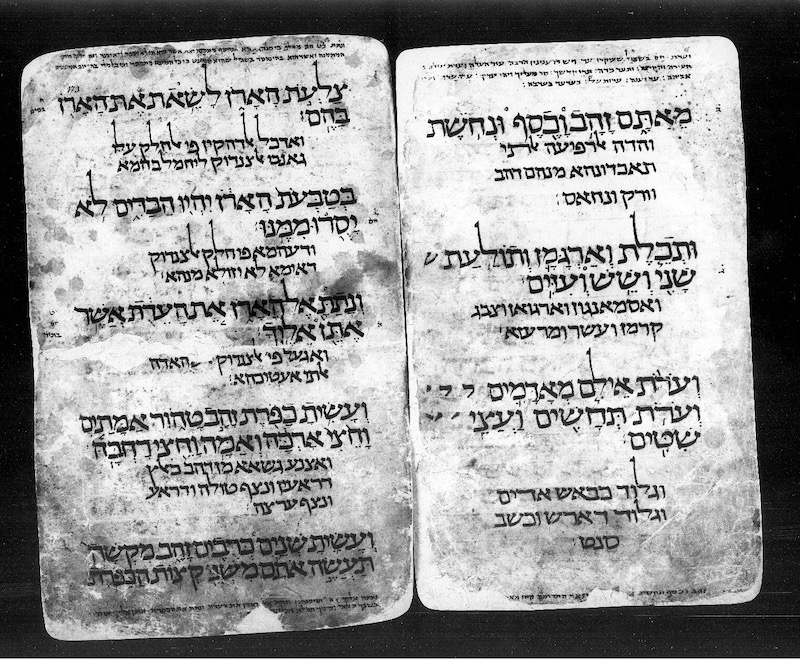
II C 1 (1d, f. 172 verso and f. 173 recto)
It appears that the text of the less densely written leaf, now stretched to fill both recto and verso, was once written upon the single page. Was this page, in fact, our T-S AS 72.79? It is difficult to be certain because all that remains of T-S AS 72.79 is the centre of the page, preventing one from discerning whether the text begins or ends at precisely the same points as the folio of II C 1. When one recalls that the verso of T-S AS 72.79 is blank, however, the theory becomes more probable: what was once contained on the recto of T-S AS 72.79 has been expanded to fill both side of f. 201 in II C 1.
3. CUL T-S Ar.1a.38 and Its Replacement Leaf in II C 1
The two leaves of T-S Ar.1a.38 are torn in half; only the bottom of each remains. The text of f. 2 contains Exodus 32:2b–3a and the text of f. 1 begins three verses later with Exodus 32:6b–7a. As the verso of both leaves are blank, and because the gap of text is approximately that required for the intervening two verses in Exodus 32, it appears that these two leaves were once placed sequentially—albeit with the intervening blank verso of f. 2.
The final extant portion of T-S Ar.1a.38 (f. 1r) concludes with exactly the same word of verse seven (מֵאֶרֶץ) as that found in II C 1 (f. 201 verso, 1d), which would indicate either (1) the use of one text as an exemplar in creating the other or (2) the need to end the text at exactly the same point due to the replacement of a leaf. The first option can be discarded because the two Genizah leaves are not elsewhere identical in layout to II C 1; only at the conclusion of f. 1 of T-S Ar.1a.38 are the two precisely in step.
The second option becomes more attractive, moreover, when examining the text density of the ‘replaced’ leaf in II C 1. II C 1 (f. 201, 1d) transgresses the clearly ruled left margin at every opportunity, giving the impression that the scribe was seeking to make up space by fitting as many words as practically possible into each line. Only upon reaching v. 6 did the scribe, realising that he had achieved his space requirements, resume spacing the text so that the left margin did not overrun. The following image shows the typical text density of the codex (right side) as compared to the crowded writing of our folio on the left.
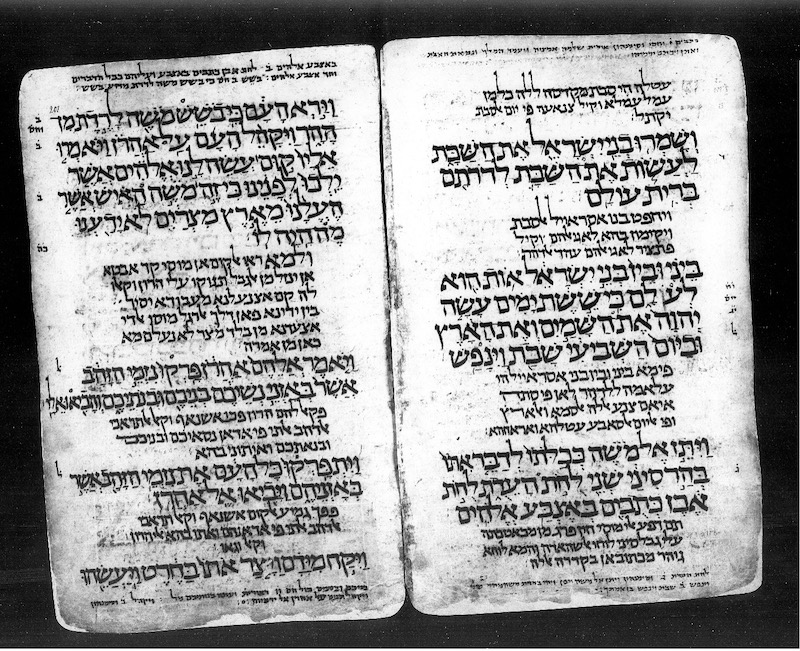
II C 1 (1d, f. 200 verso and f. 201 recto)
There are 425 Hebrew characters on the recto and verso of f. 201 (II C 1, 1d), which is well above average density for the codex—not an impossible number of letters, but one that is highly improbable had the leaf been written in sequential order with the surrounding leaves. What has happened? One explanation is that there were once three pages here, each blank on the verso, that were compressed into two. This would have yield ca. 142 Hebrew letters per page—a more reasonable text density than that shown in the image above. Alternatively, perhaps some sort of haplography or other scribal error occurred that necessitated the leaf’s removal.4
4. Leaves with a Blank Verso
The above arguments lead to several questions regarding the codex II C 1. First, why would a codex be written with text on only one side of each leaf? Secondly, are there other leaves of the codex II C 1 that are similarly single-sided? We shall take the second question first. A careful examination of II C 1 microfilms reveals that at least some of the leaves of II C 1 are single-sided. This claim can be made – despite the lack of images attesting to blank leaves – because some leaves are damaged in such a way that the ostensible recto and verso cannot be part of the same leaf, yet the text of the Torah continues without interruption. For example, the below image is of a largely extant leaf that comprises Numbers 8:6–9:
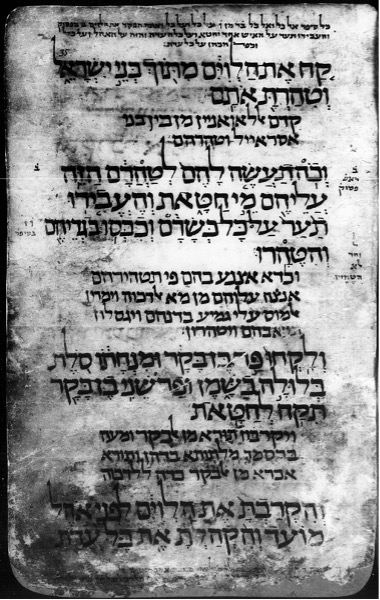
II C 1 (1c, f. 35 r)
However, what should be the verso of the above image is much more damaged. Note the holes in the middle of the leaf.
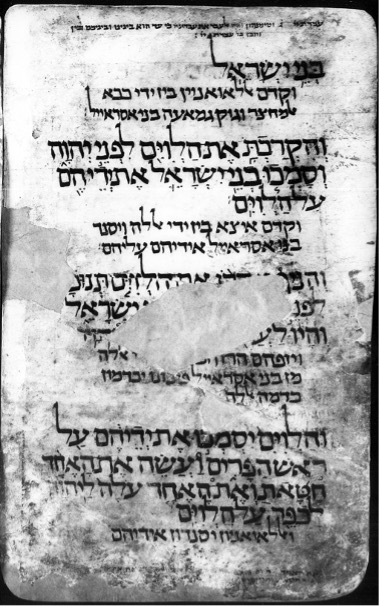
II C 1 (1c, 35 v)
Regarding why a codex (or Genizah fragment) would be blank on the reverse,5 I suggest the following: the paper of the codex, deemed too thin to provide adequate durability, was made stronger by pasting two sheets together. This resulted in leaves that, although technically written on both sides, were actually part of two separate pieces of paper. Over time these leaves delaminated, resulting in a number of leaves from II C 1 that appear to be blank on the reverse. One can see the same pattern when comparing the two Genizah fragments of Exodus 32: namely, the damage to the leaves and the marking pattern on the blank verso of each indicates that the leaves were not placed sequentially but back-to-back – that is, pasted together.
While only an in situ examination can confirm the number of leaves which are written on only one side and the reason for it, the fact remains that II C 1, an already sizeable codex, does not always contain writing on both sides of a leaf.
5. The Codices of Samuel ben Jacob
The above explanation for the origin of the three Genizah fragments from a Samuel ben Jacob codex is not consequential for most research. However, it allows Samuel ben Jacob, an apparent overachiever due to his prolific scribal output, to assume a slightly more modest stance. The list of codices attributed to Samuel ben Jacob can now be listed as follows.
Those with explicit colophons signed by Samuel ben Jacob:
- St Petersburg EVR I Bibl. 19a (Leningrad Codex), a complete Bible
- Gottheil 14, a codex of the Torah
- Gottheil 27, a codex of the Former Prophets
- St Petersburg EVR II C 1, CUL T-S AS 72.79, and CUL T-S Ar.1a.38. A codex of the Torah.6
In addition to the above four, one can add with relative confidence:
- St Petersburg EVR I Bibl. 13 and St Petersburg EVR I Bibl. 80. A codex of the Former Prophets.7
- CUL T-S A2.46 and CUL T-S A3.35. A codex of the Torah. Only two leaves are extant, but it does not appear to be a part of any other codex written by Samuel ben Jacob.8
- St Petersburg EVR II B 60+, a codex of the Torah. In addition to classmark II B 60, there are an additional nine classmarks that jointly comprise this codex.9
Zewi has also suggested that St Petersburg EVR II A 640 may be by Samuel ben Jacob, although that assertion, in my estimation, is far from certain.10 We find also in the Cairo Genizah a legal document (CUL T-S 10J5.15) wherein Samuel ben Jacob agrees to copy a Bible containing the eight books of the Prophets and the Writings. Whether this codex is one of the above codices, or a different one entirely is hard to say.11 Finally, there is also St Petersburg EVR II B 142, a codex of the Torah, that was purportedly proofread by Samuel ben Jacob; the attribution, however, may be spurious.
Footnotes
1 Ronny Vollandt, “Two Fragments (T-S AS 72.79 and T-S Ar.1a.38) of Saadiah’s tafsīr by Samuel ben Jacob,” Fragment of the Month, Cambridge University Library, November 2009.
2 For the width of the Genizah fragments, see the Davis catalogue at entry “T-S Ar.1a.38”; the width of II C 1 is listed on Ktiv, the database of Hebrew manuscripts maintained by the National Library of Israel. See https://www.nli.org.il/en/discover/manuscripts/hebrewmanuscripts/itempag....
3 In Vincent Beiler, “Another Codex by Samuel ben Jacob? The Ten Classmarks of St Petersburg EVR II B 60+”, forthcoming, there is a long list of paratextual similarities between the putative ben Jacob codices. When these comparisons are done systematically, the evidence for ben Jacob authorship becomes compelling.
4 Such errors, all hypothetical, are not to be found on the extant portions of the Genizah fragments. Yosef Ofer, “Hebrew Bible Manuscripts Written by Shmuel ben Yaakov,” conference presentation, 11th Congress of the European Association of Jewish Studies, Kraków, Poland, 16 July 2018, has observed several minor imprecisions in the text of II C 1 when compared against the Genizah fragments. The differences (e.g., II C 1 lacks the clarifying וחד מלא֯ on a Masorah note) are the type of imprecisions that routinely occur in many Bible codices, and thus, pace Ofer, are not to be considered differences of significance between the two leaves when considering which leaf may have been written first. The written version of the talk, upon which my comments here are based, was generously made available to me by Yosef Ofer, whose careful work on Samuel ben Jacob served as an important catalyst for my own interest.
5 Ofer (see n. 4), has suggested that the blank page of T-S AS 72.79 is due to an otherwise unattested tradition of dividing the book of Exodus at Parashat Terumah rather than at Parashat Mishpatim.
6 As some point, perhaps even from the outset (?), the codex was bound into two separate books, probably for reasons of practicality. The first book is comprised of Gen–Lev and the second book contains Num. and Deut.
7 Kim Phillips, “A New Codex from the Scribe behind the Leningrad Codex: L17”, Tyndale Bulletin 68/1 (2017), pp. 1–29.
8 Kim Phillips, “The Masora Magna of Two Biblical Fragments from the Cairo Genizah, and the Unusual Practice of the Scribe behind the Leningrad Codex”, Tyndale Bulletin 67/2 (2016), pp. 287–307; idem, “Two New Fragments from the Scribe behind the Leningrad Codex (B19a)”, The Hebrew Bible Manuscripts: A Millennium, Élodie Attia and Antony Perrot (eds.) (Leiden: Brill, 2022), pp. 199–217.
9 For the original attribution of II B 60 to Samuel ben Jacob, see Ofer, n. 4; for the matches of the ten classmarks of II B 60+, see Beiler, n. 3.
10 Tamar Zewi, “MS St. Petersburg RNL Yevr. II A 640: A Possible Remnant of Another Copy of Saadya Gaon’s Tafsīr by Samuel ben Jacob”, Vetus Testamentum 71 (2021), pp. 120–32.
11 Benjamin M. Outhwaite, “Beyond the Leningrad Codex: Samuel b. Jacob in the Cairo Genizah”, Studies in Semitic Linguistics and Manuscripts: A Liber Discipulorum in Honour of Professor Geoffrey Khan, Nadia Vidro et al. (eds.) (Uppsala: Uppsala University Library, 2018), pp. 320–40, esp. pp. 330–33.
Cite this article
Beiler, Vince. 2022. “Genizah Fragments of Saadiah’s Tafsīr by Samuel Ben Jacob: T-S AS 72.79 and T-S Ar.1a.38 Revisited.” Taylor-Schechter Genizah Research Unit. doi:10.17863/CAM.99640.
If you enjoyed this Fragment of the Month, you can find others here.
Contact us: genizah@lib.cam.ac.uk
The manuscripts in this article are part of the Cairo Genizah Collection in Cambridge University Library. To see more items from this collection visit: https://cudl.lib.cam.ac.uk/

